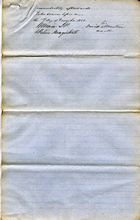At the time of the gold rushes in Victoria, inquests were held before a coroner to establish the cause of death of anyone who was killed, or who died suddenly under suspicious or unclear circumstances. An inquest could also be held into the cause and origin of any fire that resulted in destruction of or damage to property. These legal inquiries were generally held locally, but the registration of the findings and storage of the records was carried out centrally by the Registrar General.
Susan Lawrence relates how public records, such as inquest documents, can help illuminate the lives of ordinary people and communities on the diggings by allowing us to hear the voices of people who have otherwise left few first-hand accounts of their lives. Inquests, through the depositions of witnesses and experts trying to piece together the story of a death, provide, as Lawrence puts it, ‘windows through which we can see customs in the mining community, family relations, and patterns of work and industry.’
The selection of inquest documents from Public Record Office Victoria (accessible by the thumbnails on the right side of this page, or when you click on the Sources tab) offer glimpses of life on the Victorian goldfields in the 1850s.











